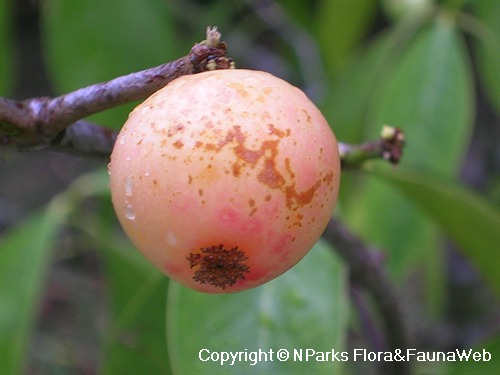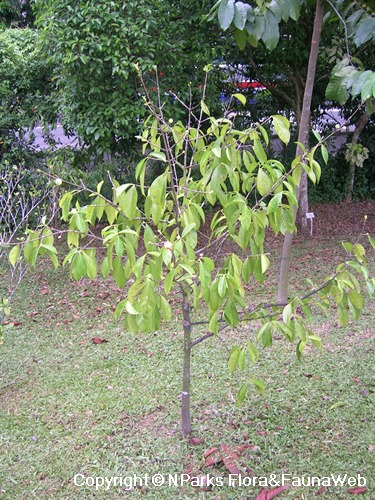
Back
Garcinia nitida Pierre
| Family Name: | Clusiaceae (Guttiferae) |
| Common Name: | Brunei Cherry, Asam Kandis, Asam Aur-aur, Kandis |
Name
Classifications and Characteristics
| Plant Division | Angiosperms (Flowering Seed Plants) (Dicotyledon) |
|---|---|
| Plant Growth Form | Tree |
| Lifespan (in Singapore) | Perennial |
| Mode of Nutrition | Autotrophic |
Biogeography
| Native Distribution | Borneo |
|---|---|
| Native Habitat | Terrestrial |
| Preferred Climate Zone | Tropical |
Description and Ethnobotany
| Foliage | Leaves are simple, arranged in opposite to alternate pairs, obovate to oval-elliptic, tapering to the tip. |
|---|---|
| Fruit | Fruits are globose to sub-globose, measuring up to 4 cm in diameter. Unripe fruits are pale green and become pinkish red when fully ripe. |
| Etymology | The genus is named for Laurent Garcin, a French naturalist with the East India company, traveled in the orient in 18th century. |
| Ethnobotanical Uses | Edible Plant Parts : Edible Fruits Food (Fruit or Vegetable): The fruit has an acid flavor, consumed raw or used for flavoring. Others: Plants are also used as rootstocks for Garcinia mangostana. |
Landscaping Features
| Desirable Plant Features | Ornamental Fruits |
|---|---|
| Landscape Uses | Parks & Gardens |
| Thematic Landscaping | Economic Garden |
Plant Care and Propagation
| Light Preference | Full Sun |
|---|---|
| Water Preference | Moderate Water |
| Plant Growth Rate | Moderate |
| Rootzone Tolerance | Moist Soils, Well-Drained Soils, Fertile Loamy Soils |
| Propagation Method | Seed |
Foliar
| Foliage Retention | Evergreen |
|---|---|
| Mature Foliage Colour(s) | Green |
| Mature Foliage Texture(s) | Smooth, Leathery |
| Foliar Type | Simple / Unifoliate |
| Leaf Area Index (LAI) for Green Plot Ratio | 4.0 (Tree - Dense Canopy) |
Fruit, Seed and Spore
| Mature Fruit Colour(s) | Pink, Red |
|---|---|
| Fruit Type | Fleshy Fruit |
Image Repository
Others
| Master ID | 1635 |
|---|---|
| Species ID | 2928 |
| Flora Disclaimer | The information in this website has been compiled from reliable sources, such as reference works on medicinal plants. It is not a substitute for medical advice or treatment and NParks does not purport to provide any medical advice. Readers should always consult his/her physician before using or consuming a plant for medicinal purposes. |





